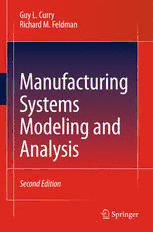Table Of ContentManufacturing Systems Modeling and Analysis
Second Edition
·
Guy L. Curry Richard M. Feldman
Manufacturing Systems
Modeling and Analysis
Second Edition
123
Prof.GuyL.Curry RichardM.Feldman
TexasA&MUniversity TexasA&MUniversity
Dept.Industrial&Systems Dept.Industrial&Systems
Engineering Engineering
TAMU3131 TAMU3131
77843-3131CollegeStation 77843-3131CollegeStation
Texas Texas
241,Zachry 241,Zachry
USA USA
[email protected] [email protected]
ISBN978-3-642-16617-4 e-ISBN978-3-642-16618-1
DOI10.1007/978-3-642-16618-1
SpringerHeidelbergDordrechtLondonNewYork
LibraryofCongressControlNumber:2010938859
(cid:2)c Springer-VerlagBerlinHeidelberg2009,2011
Thisworkissubjecttocopyright.Allrightsarereserved,whetherthewholeorpartofthematerialis
concerned,specificallytherightsoftranslation,reprinting,reuseofillustrations,recitation,broadcasting,
reproductiononmicrofilmorinanyotherway,andstorageindatabanks.Duplicationofthispublication
orpartsthereofispermittedonlyundertheprovisionsoftheGermanCopyrightLawofSeptember9,
1965,initscurrentversion,andpermissionforusemustalwaysbeobtainedfromSpringer.Violations
areliabletoprosecutionundertheGermanCopyrightLaw.
Theuseofgeneraldescriptivenames,registerednames,trademarks,etc.inthispublicationdoesnot
imply,evenintheabsenceofaspecificstatement,thatsuchnamesareexemptfromtherelevantprotective
lawsandregulationsandthereforefreeforgeneraluse.
Coverdesign:eStudioCalamarS.L.
Printedonacid-freepaper
SpringerispartofSpringerScience+BusinessMedia(www.springer.com)
Thisbookisdedicatedtothetwoindividuals
whokeepusgoing,tolerateourworkethic,
andmakelifeawondrousjourney,ourwives:
JerrieCurryandAliceFeldman.
Preface
This textbook was developed to fill the need for an accessible but comprehensive
presentation of the analytical approaches for modeling and analyzing models of
manufacturing and production systems. It is an out growth of the efforts within
theIndustrialandSystemsEngineeringDepartmentatTexasA&Mtodevelopand
teachananalyticallybasedundergraduatecourseonprobabilisticmodelingofman-
ufacturingtypesystems.Thelevelofthistextbookisdirectedatundergraduateand
masters students in engineering and mathematical sciences. The only prerequisite
forstudentsusingthistextbookisapreviouscoursecoveringcalculus-basedprob-
abilityandstatistics.Theunderlyingmethodologyisqueueingtheory,andweshall
develop the basic concepts in queueing theory in sufficient detail that the reader
need not have previously covered it. Queueing theory is a well-established disci-
plinedatingbacktotheearly1900’sworkofA.K.Erlang,aDanishmathematician,
on telephone traffic congestion. Although there are many textbooks on queueing
theory,thesetextsaregenerallyorientedtothemethodologicaldevelopmentofthe
fieldandexactresultsandnottothepracticalapplicationofusingapproximations
inrealisticmodelingsituations.Theapplicationofqueueingtheorytomanufactur-
ing type systems started with the approximation based work of Ward Whitt in the
1980’s.HispaperonQNA(aqueueingnetworkanalyzer)in1983isthebasefrom
whichmostappliedmodelingeffortshaveevolved.
There are several textbooks with titles similar to this book. Principle among
these are: Modeling and Analysis of Manufacturing Systems by Askin and Stan-
dridge, Manufacturing Systems Engineering by Stanley Gershwin, Queueing The-
ory in Manufacturing Systems Analysis and Design by Papadopoulos, Heavey
and Browne, Performance Analysis of Manufacturing Systems by Tayfur Altiok,
StochasticModelingandAnalysisofManufacturingSystems,editedbyDavidYao,
and Stochastic Models of Manufacturing Systems by Buzacott and Shanthikumar.
Each of these texts, along with several others contributes greatly to the field. The
book that most closely aligns with the motivation, level, and intent of this book
is Factory Physics by Hopp and Spearman. Their approach and analysis is highly
recommendedreading,however,theirbook’sscopeisonthelargerfieldofproduc-
vii
viii Preface
tionandoperationsmanagement.Thus,itdoesnotprovidethedepthandbreathof
analyticalmodelingproceduresthatarepresentedinthistext.
Thistextisaboutthedevelopmentofanalyticalapproximationmodelsandtheir
useinevaluatingfactoryperformance.Thetoolsneededfortheanalyticalapproach
are fully developed. One useful non-analytical tool that is not fully developed in
this textbook is simulation modeling. In practice as well as in the development of
the models in this text, simulation is extensively used as a verification tool. Even
thoughthedevelopmentofsimulationmodelsisonlymodestlyaddressed,wewould
encourageinstructorswhousethisbookintheircurriculumafterasimulationcourse
to ask students to simulate some of the homework problems so that a comparison
canbemadeoftheanalysisusingthemodelspresentedherewithsimulationmod-
els. By developing simulation models students will have a better understanding of
themodelingassumptionsandtheaccuracyoftheanalyticalapproximations.Inad-
dition several chapters include an appendix that contains instructions inthe use of
MicrosoftExcelasanaidinmodelingorinbuildingsimplesimulationmodels.
Forthissecondedition,suggestionsfromvariousinstructorswhohaveusedthe
textbook havebeenincorporated.Becauseoftheimportanceofsimulationmodel-
ing,thissecondeditionalsoincludesanintroductiontoevent-drivensimulations.
Twospecialsectionsareincludedtohelpthereaderorganizethemanyconcepts
containedinthetext.ImmediatelyaftertheTableofContents,wehaveincludeda
symbol table that contains most of the notation used throughout the text. Second,
immediatelyafterthefinalchapteraglossaryoftermsisincludedthatsummarizes
thevariousdefinitionsused.Itisexpectedthatthesewillprovevaluableresources
asthereaderprogressesthroughthetext.
Many individuals have contributed to this book through our interactions in re-
searcheffortsanddiscussions.SpecialthanksgotoProfessorMartinA.Wortman,
TexasA&MUniversity,whodesignedandtaughtthefirstpresentationofthecourse
forwhichthisbookwasoriginallydevelopedandProfessorBryanL.Deuermeyer,
Texas A&M University, for his significant contributions to our joint research ac-
tivities in this area and his continued interest and criticism. In addition several in-
dividuals have helped in improving the text by using a draft copy while teaching
the material to undergraduates including Eylem Tekin at Texas A&M, Natarajan
GautamalsoatTexasA&M,andKevinGueatAuburnUniversity.Wealsowishto
acknowledgethecontributionsofProfessorsJohnA.Fowler,ArizonaStateUniver-
sity,andMarkL.Spearman,FactoryPhysics,Inc.,fortheircontinuedinteractions
anddiscussionsonmodelingmanufacturingsystems.AndwethankCiriacoValdez-
Flores,aco-authorofthefirstchaptercoveringbasicprobabilityforpermissionto
includeitaspartofourbook.Finally,weacknowledgeourthanksthroughthewords
ofthepsalmist,“GivethankstotheLord,forHeisgood;Hisloveenduresforever.”
(Psalms107:1,NIV)
CollegeStation,Texas GuyL.Curry
March2008 RichardM.Feldman
Contents
1 BasicProbabilityReview........................................ 1
1.1 BasicDefinitions........................................... 1
1.2 RandomVariablesandDistributionFunctions................... 4
1.3 MeanandVariance ......................................... 10
1.4 ImportantDistributions...................................... 13
1.5 MultivariateDistributions.................................... 24
1.6 CombinationsofRandomVariables ........................... 32
1.6.1 FixedSumofRandomVariables ....................... 32
1.6.2 RandomSumofRandomVariables ..................... 33
1.6.3 MixturesofRandomVariables ......................... 35
Appendix ...................................................... 36
Problems ...................................................... 37
References..................................................... 44
2 IntroductiontoFactoryModels.................................. 45
2.1 TheBasics ................................................ 45
2.1.1 Notation,DefinitionsandDiagrams..................... 46
2.1.2 MeasuredDataandSystemParameters .................. 49
2.2 IntroductiontoFactoryPerformance........................... 54
2.2.1 TheModelingMethod................................ 55
2.2.2 ModelUsage........................................ 58
2.2.3 ModelConclusions................................... 59
2.3 DeterministicvsStochasticModels ........................... 60
Appendix ...................................................... 62
Problems ...................................................... 65
References..................................................... 67
3 SingleWorkstationFactoryModels .............................. 69
3.1 FirstModel................................................ 69
3.2 DiagramMethodforDevelopingtheBalanceEquations .......... 73
3.3 ModelShorthandNotation................................... 76
ix
x Contents
3.4 AnInfiniteCapacityModel(M/M/1) ......................... 77
3.5 MultipleServerSystemswithNon-identicalServiceRates ........ 81
3.6 UsingExponentialstoApproximateGeneralTimes .............. 85
3.6.1 ErlangProcessingTimes .............................. 85
3.6.2 ErlangInter-ArrivalTimes ............................ 87
3.6.3 PhasedInter-arrivalandProcessingTimes ............... 89
3.7 SingleServerModelApproximations.......................... 90
3.7.1 GeneralServiceDistributions .......................... 91
3.7.2 ApproximationsforG/G/1Systems .................... 93
3.7.3 ApproximationsforG/G/cSystems .................... 95
Appendix ...................................................... 97
Problems ......................................................100
References.....................................................107
4 ProcessingTimeVariability .....................................109
4.1 NaturalProcessingTimeVariability ...........................111
4.2 RandomBreakdownsandRepairsDuringProcessing ............113
4.3 Operator-MachineInteractions ...............................115
Problems ......................................................121
References.....................................................123
5 Multiple-StageSingle-ProductFactoryModels ....................125
5.1 ApproximatingtheDepartureProcessfromaWorkstation.........125
5.2 SerialSystemsDecomposition ...............................128
5.3 NonserialNetworkModels ..................................133
5.3.1 MergingInflowStreams ..............................133
5.3.2 RandomSplittingoftheDepartureStream ...............135
5.4 TheGeneralNetworkApproximationModel....................138
5.4.1 ComputingWorkstationMeanArrivalRates..............139
5.4.2 ComputingSquaredCoefficientsofVariationforArrivals ..141
Appendix ......................................................150
Problems ......................................................152
References.....................................................157
6 MultipleProductFactoryModels ................................159
6.1 ProductFlowRates.........................................160
6.2 WorkstationWorkloads......................................162
6.3 ServiceTimeCharacteristics .................................163
6.4 WorkstationPerformanceMeasures ...........................164
6.5 ProcessingStepModelingParadigm...........................167
6.5.1 ServiceTimeCharacteristics...........................170
6.5.2 PerformanceMeasures ...............................172
6.5.3 AlternateApproaches.................................174
1Section4.3canbeomittedwithoutaffectingthecontinuityoftheremainderofthetext.
2Section6.5.3canbeomittedwithoutaffectingthecontinuityoftheremainderofthetext.

